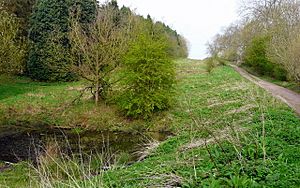Little Wittenham SSSI facts for kids
| Site of Special Scientific Interest | |
 |
|
| Area of Search | Oxfordshire |
|---|---|
| Interest | Biological |
| Area | 68.9 hectares (170 acres) |
| Notification | 2000 |
| Location map | Magic Map |
Little Wittenham SSSI is a special natural area in Oxfordshire, England. It covers about 68.9-hectare (170-acre) (which is about 170 acres) of land. This site is officially known as a Site of Special Scientific Interest (SSSI) because of its important plants and animals. It's also a Special Area of Conservation, which means it's protected across Europe.
Contents
What is Little Wittenham SSSI?
Little Wittenham SSSI is a beautiful place managed by the Earth Trust. It has different types of habitats, like woods, open grasslands, bushy areas (scrub), and small ponds. This special area is located on the side of a hill, right next to the famous River Thames. It's a fantastic spot for nature lovers and scientists alike!
Why is This Area So Special?
This site is very important because it's home to many different kinds of plants and animals. The mix of habitats makes it a perfect place for various species to live and thrive. Protecting areas like Little Wittenham helps keep our natural world healthy and diverse.
Unique Plants of Little Wittenham
One of the most interesting plants found here is the greater dodder. This plant is quite rare in the United Kingdom. It's a unique plant that grows by attaching itself to other plants. Finding it here shows how special the environment at Little Wittenham is.
Amazing Amphibians and Newts
Little Wittenham is also famous for its many amphibians. Amphibians are animals like frogs, toads, and newts that can live both in water and on land. The site has a very large number of these creatures.
- Great Crested Newt: One of the most important animals living here is the great crested newt. This newt is a very special and protected species. Little Wittenham has one of the biggest populations of great crested newts in the entire country! They are a "priority species" in the Biodiversity action plan, which means there are special efforts to protect them and their homes.

